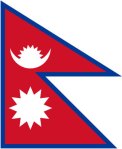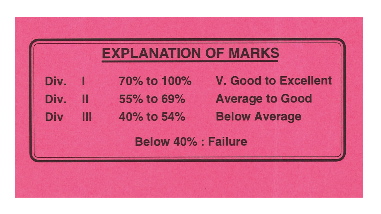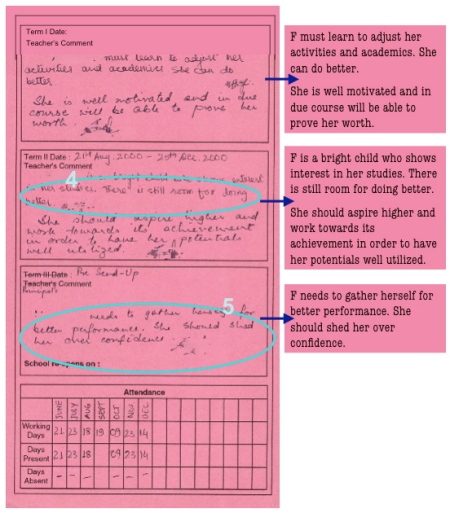For the next several weeks, we’ll look at report cards from around the world.
~ Habla Español! ~
~ 7th Stop ~ Mexico ~
.
Mexico, with 111 million people, is the 11th most populous country. While Mexico can be seen as a powerful country, with the largest GDP per capita in Latin America, issues with income disparity and drug violence continue to plague the country. With a rich and ancient history, Mexico remains a popular tourist destination (for more than the sun and lovely beaches!).
Note ~ This is an international and NOT a local school as some other countries.
.
Report Card Basics
- Type of School: British International School
- Curriculum: International Baccalaureate Primary Years Programme (PYP)
- Academic Year: 2008-2009
- Year: 3
.
Here’s the report card! The blue numbers highlight a few interesting aspects of the report and the numbers correspond to notes below the image.
1. The Five Parts of English
A large portion of the report card is dedicated to assessing English, illustrating the importance of the language at this school (English, rather than Spanish), as well as language acquisition. The assessment has been broken down into five core parts: speaking, listening, reading, writing and handwriting.
2. Look, Hear! ~ Units of Inquiry
Rather than set subjects or courses, this curriculum includes Units of Inquiry, which allow flexibility in teaching and learning. This differs greatly from educational systems that have concrete course expectations and teach to a national, standardized test. The Units of Inquiry this semester are “Look, Hear!” and “Exploration and Encounter.” Sounds fun to me!
3. A Big Old for Effort!
How age appropriate! Rather than assign a number or letter assessment of effort, this report card uses smiley faces, which can be understood regardless of age or culture. Colon, Capital D for a great practice!
4. A Descriptive Grading Scale
This report card has a slightly different grading scale than other assessments we’ve seen: good, very good and excellent, as well as reaching expectations. Reaching expectations seems to be given when a mark of “good” might be subjective, for instance, what is “good” use of information technology or “excellent” in music at 9 years old?
5. Spanish and Social Studies… Get Numbers Grades
Though I’m not sure why (and I’ve scoured the internet!) Spanish and Social Studies get numbers instead of “descriptive” grades. Hm… I’m stumped. Any suggestions?
.
See Report Cards from: Staffordshire, England; Zomba, Malawi; Sydney, Australia, week 1; Sydney, Australia, week 2; Dalhousie, India; Kathmandu, Nepal; Soro, Denmark
Report card analysis to look forward to: Palestine, Canada and more!





 Posted by findingschools
Posted by findingschools 
![himalayan_peaks_nepal_photo[1] himalayan_peaks_nepal_photo[1]](https://findingschools.files.wordpress.com/2009/10/himalayan_peaks_nepal_photo11.jpg?w=150&h=97) Kathmandu, the capital city of Nepal, which is home of the mighty Mount Everest. Though troubled by unrest in the last few years, Kathmandu remains a popular tourist destination, especially among the adventurous. As a developing country, Nepal has made enormous strides, though life expectancy (at 63 years) remains low and infant mortality rates highest in the region. Although Wikipedia suggests a 98% literacy rate in the city of Kathmandu, the World Bank reports a literacy rate of 48.2% for the country, and highlights gender disparity (female: 34.6%, male 62.2%). Regardless, Kathmandu has many schools that offer a quality education.
Kathmandu, the capital city of Nepal, which is home of the mighty Mount Everest. Though troubled by unrest in the last few years, Kathmandu remains a popular tourist destination, especially among the adventurous. As a developing country, Nepal has made enormous strides, though life expectancy (at 63 years) remains low and infant mortality rates highest in the region. Although Wikipedia suggests a 98% literacy rate in the city of Kathmandu, the World Bank reports a literacy rate of 48.2% for the country, and highlights gender disparity (female: 34.6%, male 62.2%). Regardless, Kathmandu has many schools that offer a quality education.
 Here’s the second page of the progress report:
Here’s the second page of the progress report:


Report Cards from Around the World: Sydney, Australia
October 23, 2009~ Hold on to your hats! ~
~ Fourth Stop ~ Sydney ~
.
.
Student Report Basics
Here’s the report card! The blue numbers highlight a few interesting aspects of the report and the numbers correspond to notes below the image.
1. Descriptions, Definitions and Instructions
Unlike any other report card we have seen so far, this evaluation is 11 pages long (for instance, the report cards from Dalhousie and Kathmandu are two pages and consist primarily of numbers, rather than words). While many other educational systems attempt to summarize a year’s worth of work into a page or two, this report card include descriptions of the child’s performance, definitions of expected “outcomes” and provides the parents with instructions for interpreting the report card. (Note that this is the first Elementary School report card we have analyzed). Parents, grab a cup of coffee and find a comfy seat, this might take a while!
2. Key Learning Areas determined by the New South Wales Board of Studies
Australians base the educational system and curriculum on Key Learning Areas, which consist of English; mathematics; science and technology; the arts; health and physical education; and study of human society and its environment, which includes languages other than English. The Key Learning Areas and “outcomes and guidelines for indicators” demonstrate the government’s involvement in upholding a certain standard of education.
3. Children are Different
“Children can have different learning needs and may be working towards outcomes at an earlier or later stage.” Translation ~ parents, don’t worry if you’re child is ahead in some areas and behind in others!
.
4. Progress on a Scale!
These scales show this student’s progress for the areas of English and Mathematics. This student has reached the targeted outcomes for Grade 2 (which is the second year of Stage 1), and is ready to begin Grade 3. This visual representation of progress is a relatively unique aspect to report cards!
.
5. English and Mathematics… whole numbers, volume, time, chance…
About 5 pages are dedicated to English and Mathematics and each area is broken down to the subsections listed below.
English
Mathematics
6. Your child is Competent… Developing… Needs Support…
Each area listed above includes a list of “indicators.” The teacher then marks the child’s achievement for each indicator as competent, developing or needs support. Note that these categories are stated in the positive form of the meaning (rather than, “is behind the rest of the class”). For instance, in writing, this child:
Consider how this differs from JUST a letter or number grade for mathematics in general; in comparison to all the information provided, the letter or number illustrates only the child’s standing in relation to the other students in the class. This process explains the child’s progress in relation to each task.
.
7. Social Development… at a 2nd grade level
Besides English and mathematics, students receive an assessment for Religious Education, Science and Technology, Human Society and Its Environment, Creative Arts (Music, Visual Arts, Drama) and Health and Physical Education. Teachers also assess Social Development and Work Habits. Looks like this student is “developing well” in some areas and is “highly developed” in others. Well done!
.
8. General Comments
This section allows the teacher to comment on the child’s social and academic development, noting areas that may need attention.
.
See Report Card from Dalhousie, India; Kathmandu, Nepal; Soro, Denmark
Report card analysis to look forward to: Palestine, Malawi, Australia, Canada, Mexico and more!